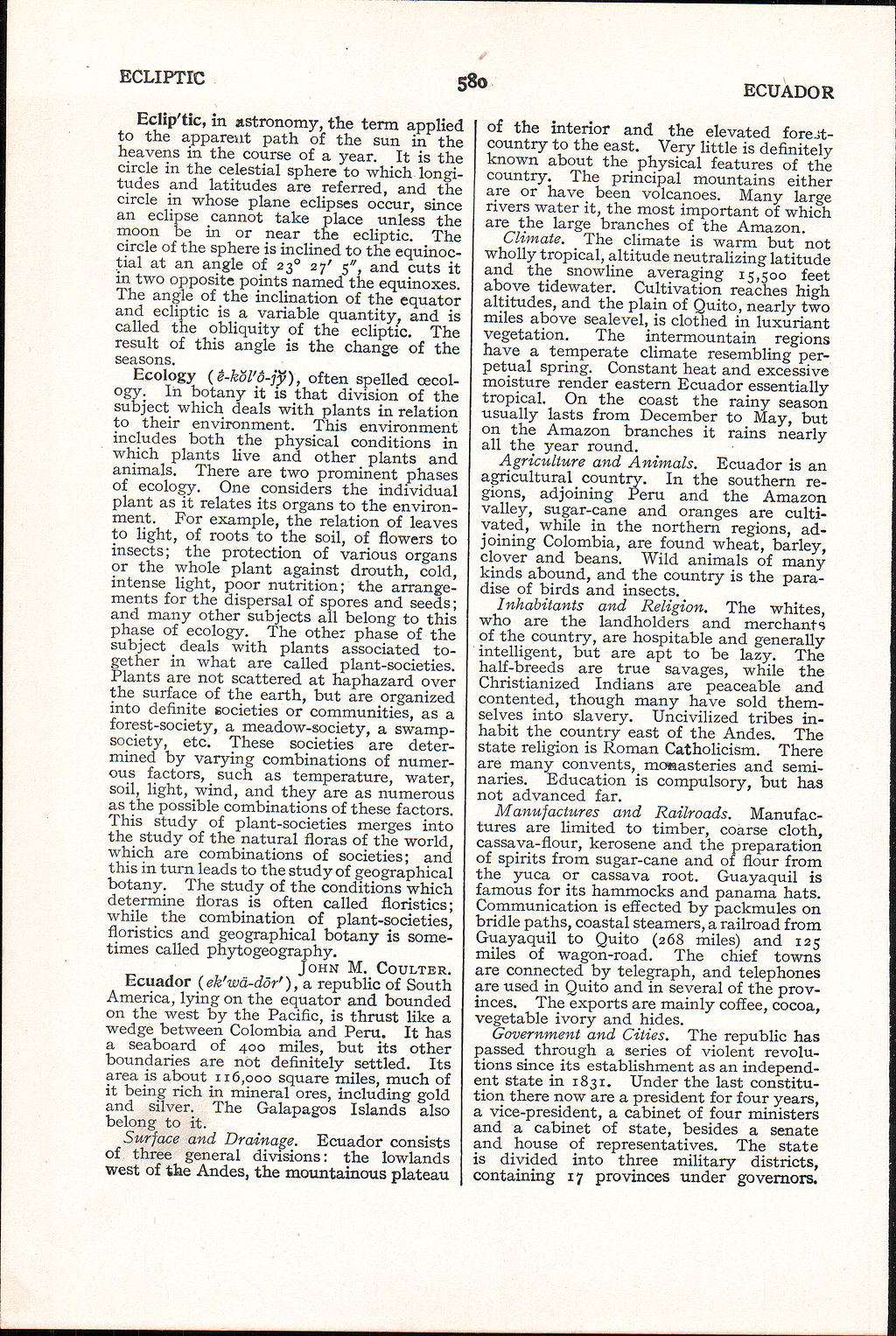Page 580 : ECLIPTIC — ECUADOR
Individual articles:
Eclip′tic, in [[../Astronomy|astronomy]], the term applied to the apparent path of the [[../Sun, The|sun]] in the heavens in the course of a year. It is the circle in the celestial sphere to which longitudes and latitudes are referred, and the circle in whose plane eclipses occur, since an [[../Eclipse|eclipse]] cannot take place unless the [[../Moon|moon]] be in or near the ecliptic. The circle of the sphere is inclined to the equinoctial at an angle of 23° 27′ 5″, and cuts it in two opposite points named the [[../Equinox|equinoxes]]. The angle of the inclination of the equator and ecliptic is a variable quantity, and is called the obliquity of the ecliptic. The result of this angle is the change of the seasons.
Ecology (ḗ-kŏl′ṓ-jy̆), often spelled œcology. In [[../Botany|botany]] it is that division of the subject which deals with plants in relation to their environment. This environment includes both the physical conditions in which plants live and other plants and animals. There are two prominent phases of ecology. One considers the individual plant as it relates its organs to the environment. For example, the relation of leaves to light, of roots to the soil, of flowers to insects; the protection of various organs or the whole plant against drouth, cold, intense light, poor nutrition; the arrangements for the dispersal of spores and seeds; and many other subjects all belong to this phase of ecology. The other phase of the subject deals with plants associated together in what are called plant-societies. Plants are not scattered at haphazard over the surface of the earth, but are organized into definite societies or communities, as a forest-society, a meadow-society, a swamp-society, etc. These societies are determined by varying combinations of numerous factors, such as temperature, water, soil, light, wind, and they are as numerous as the possible combinations of these factors. This study of plant-societies merges into the study of the natural floras of the world, which are combinations of societies; and this in turn leads to the study of geographical botany. The study of the conditions which determine floras is often called floristics; while the combination of plant-societies, floristics and geographical botany is sometimes called phytogeography.
John M. Coulter.
Ecuador (ek′ wä-dōr′), a republic of South America, lying on the equator and bounded on the west by the [[../Pacific Ocean|Pacific]], is thrust like a wedge between Colombia and Peru. It has a seaboard of 400 miles, but its other boundaries are not definitely settled. Its area is about 116,000 square miles, much of it being rich in mineral ores, including gold and silver. The Galapagos Islands also belong to it.
Surface and Drainage. Ecuador consists of three general divisions: the lowlands west of the Andes, the mountainous plateau of the interior and the elevated forest-country to the east. Very little is definitely known about the physical features of the country. The principal mountains either are or have been [[../Volcanoes|volcanoes]]. Many large rivers water it, the most important of which are the large branches of the Amazon.
Climate. The climate is warm but not wholly tropical, altitude neutralizing latitude and the snowline averaging 15,500 feet above tidewater. Cultivation reaches high altitudes, and the plain of Quito, nearly two miles above sealevel, is clothed in luxuriant vegetation. The intermountain regions have a temperate climate resembling perpetual spring. Constant heat and excessive moisture render eastern Ecuador essentially tropical. On the coast the rainy season usually lasts from December to May, but on the Amazon branches it rains nearly all the year round.
Agriculture and Animals. Ecuador is an agricultural country. In the southern regions, adjoining Peru and the Amazon valley, sugar-cane and oranges are cultivated, while in the northern regions, adjoining Colombia, are found wheat, barley, clover and beans. Wild animals of many kinds abound, and the country is the paradise of birds and insects.
Inhabitants and Religion. The whites, who are the landholders and merchants of the country, are hospitable and generally intelligent, but are apt to be lazy. The half-breeds are true savages, while the Christianized Indians are peaceable and contented, though many have sold themselves into slavery. Uncivilized tribes inhabit the country east of the Andes. The state religion is Roman Catholicism. There are many convents, monasteries and seminaries. Education is compulsory, but has not advanced far.
Manufactures and Railroads. Manufactures are limited to timber, coarse cloth, cassava-flour, kerosene and the preparation of spirits from sugar-cane and of flour from the yuca or cassava root. Guayaquil is famous for its hammocks and panama hats. Communication is effected by packmules on bridle paths, coastal steamers, a railroad from Guayaquil to Quito (268 miles) and 125 miles of wagon-road. The chief towns are connected by telegraph, and telephones are used in Quito and in several of the provinces. The exports are mainly [[../Coffee|coffee]], [[../Cocoa|cocoa]], [[../Ivory, Vegetable|vegetable ivory]] and hides.
Government and Cities. The republic has passed through a series of violent revolutions since its establishment as an independent state in 1831. Under the last constitution there now are a president for four years, a vice-president, a cabinet of four ministers and a cabinet of state, besides a senate and house of representatives. The state is divided into three military districts, containing 17 provinces under governors.
